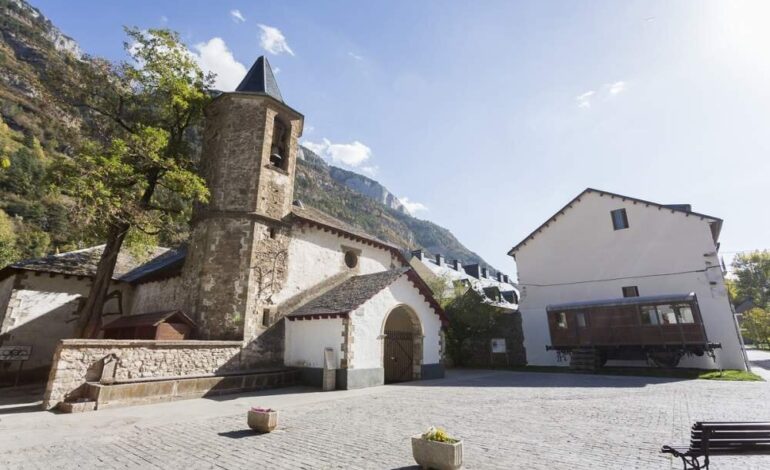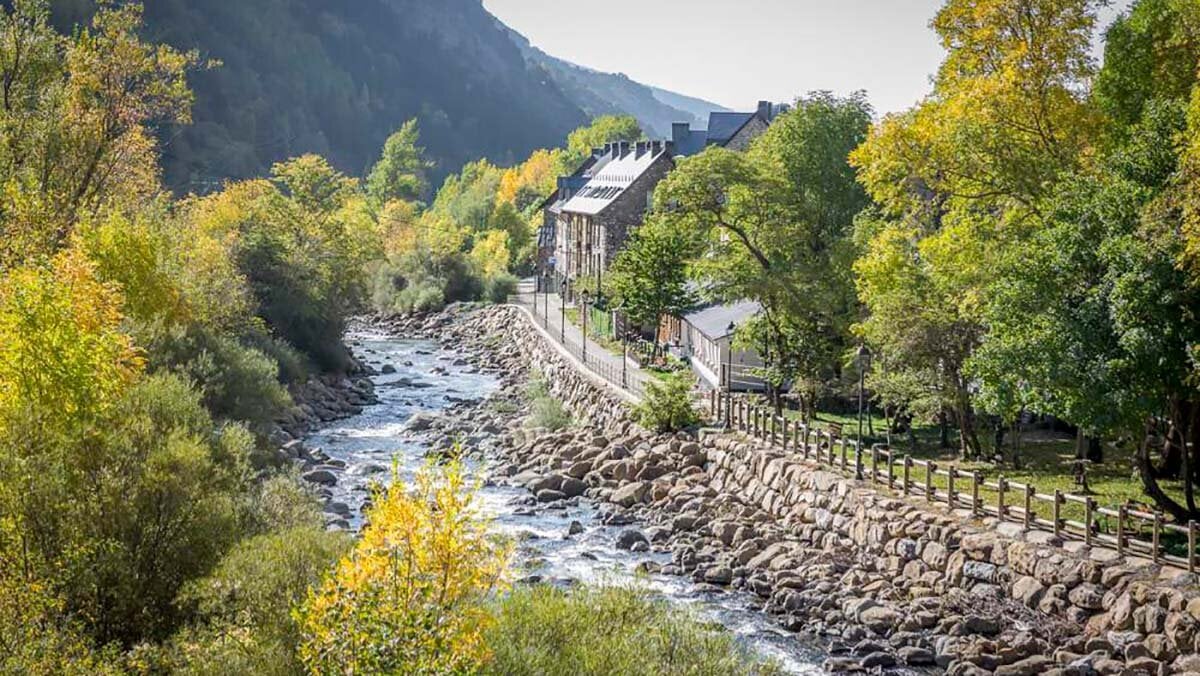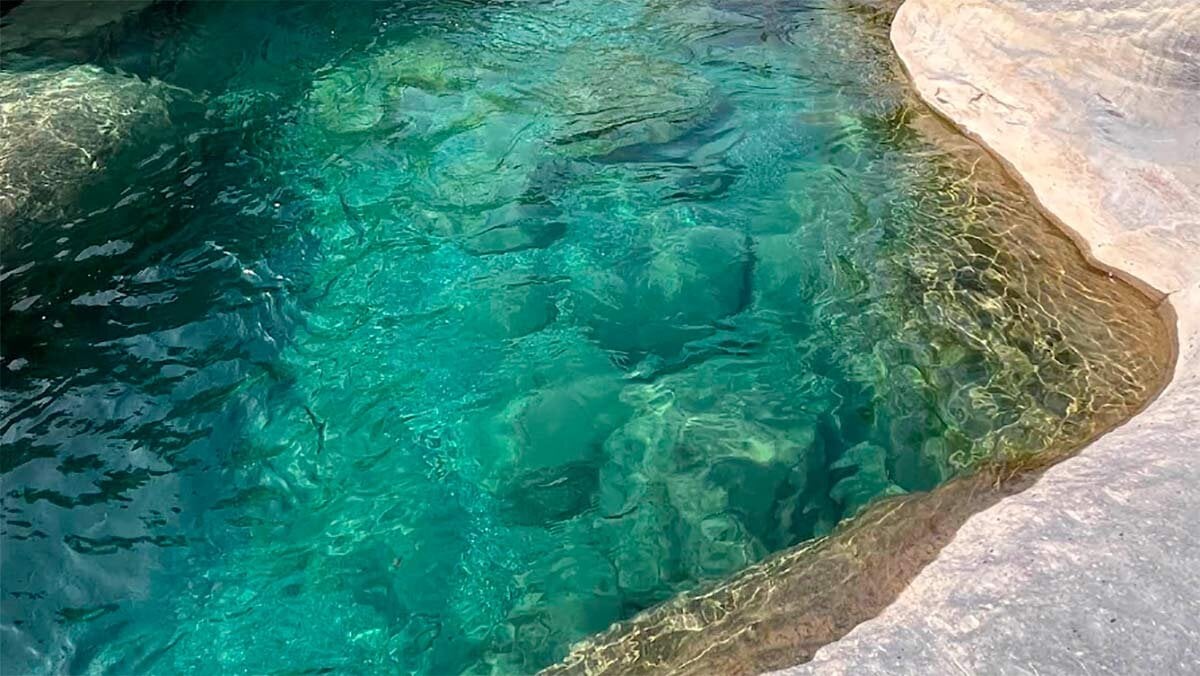
The town of Huesca where spies, Nazi gold and fugitives were crossed: their station hides a movie story
During World War II, in a remote corner of the Pyrenees Aragonese, a monumental rail building became the scene of intense clandestine activity. Allied and non -allied spies passed through it, falsified documents and camouflaged goods were crossed, and secret networks were woven that connected with the French resistance. It was also a key route to the smuggling of Wolframium and Nazi gold, in an operation as silent as decisive. What seemed like an isolated terminal between mountains was, in fact, a strategic center in full European conflict, as discreet as it is essential.

The Canfranc International Station is a monumental jewel that captivates its architecture and history. Photo: M. G.
Canfranc International Station
What to do and what to do in Canfranc
At the beginning of the 20th century, Spain and France set out to join their railway roads crossing the Pyrenees through a tunnel that seemed unreal. But they made it possible: they built the Somport tunnel, almost 8 kilometers, and lifted in Canfranc, a small town of high Aragon, one of the largest and most spectacular stations in Europe, more than 240 meters in length, with an imperial capital design. Inaugurated in 1928, it was a symbol of modernity, of international cooperation … and also, soon, of decline.
Today, Canfron has resurfaced as a unique destination that combines history, architecture, mountain and legend. Its restored station is a magnet for the curious, but the town offers much more: it is a key point of the Camino de Santiago Aragonese, it is surrounded by mountain routes, it is a refuge of skiers in winter and gastronomic epicenter at any time of the year. In addition, it is an excellent basis for exploring Jacetania, a region where natural beauty and historical legacy shake hands in each valley, in each town, in each stone. Canfranc is not just a place: it is a living story.
Canfranc International Station
The Canfranc International Station is a monumental jewel that captivates its architecture and history. When it was inaugurated on July 18, 1928 by King Alfonso XIII, it was the second largest railway station in Europe, with a length of 241 meters, more than 150 doors and about 350 windows that continue to impress the visitor.
The origin of the project dates back to 1853, when the Royal Economic Society of Friends of the Country promoted the construction of a railway line that connected Spain and France through Canfranc. The result was a building designed by the engineer Fernando Ramírez Dampierre, who should not only fulfill a logistics function, but also to show the country’s greatness to international travelers.

The station had a hotel, casino, customs and offices. Photo: Canfranc Hotel
Built with noble materials, with modernist and neoclassical influences, the station had a hotel, casino, customs, offices and everything necessary to welcome passengers of international trains. Its geostrategic importance was such that during World War II it became a key point for the passage of gold, stolen works of art and Jews fleeing from the Nazi regime, which has given it an aura of legend that still survives.
After the closure of the international line in 1970, the station fell into abandonment for decades. However, in recent years, an ambitious rehabilitation process has been carried out that has returned all its splendor to this symbol of Aragon’s rail history. Today, much of the building hosts a luxury hotel with high -level services, while the other party can be visited by guided routes from the Canfranc Tourism Office.
How to visit the Canfranc station
You can do it for free, where you can enter the hotel lobby, walk outside the building and cross the new train station, where you will find the modern lobby, the platform and other spaces open to the public.
Or make a guided tour whose price is 4 euros, with reduced rate of 1.50 euros for children from 6 to 10 years. Children under 6 years enter free. Tickets are acquired the same day in the office, without the possibility of anticipated reserve by email or telephone. A good option if you want to learn more about the history of the station.
What to do and what to do in Canfranc
Rifle turret
Located a few meters from the Canfranc Estación nucleus, the rifle turret (also known as the scratch castle) was built in 1876 as part of the Pyrenees defensive system, with the aim of controlling access by the road of the port of Somport. This three -story round tower, raised in Sillar stone, was designed by Captain José San Gil and served as a surveillance and defense post to a possible French incursion. It had a pit, drawbridge and riflers for riflers.
At present, the tower is listed as a cultural interest and is visited regularly through the guided routes organized by the Canfranc Tourism Office. Visits are usually integrated into the route that also includes the monumental environment of the International Station. In summer of 2025, the visits schedule is from Tuesday to Sunday, with passes at 10.00, 12.00, 16.00 and 18.00 hours, and the general price is 5 euros (reduced to 3 euros for children, students and over 65 years old). It is recommended to reserve on the official Tourism website of Canfronc or by phone.
Strong coll of thieves
At 1,351 meters of altitude and surrounded by a steep landscape, the Fort of Coll de thieves is one of the most impressive military constructions of Alto Aragón. Its first version dates back to the end of the 16th century, but the current building was built between 1888 and 1900, in response to the construction of the French Fort of the Portalet on the opposite side of the Valley. Its function was to monitor and protect the border crossing through the port of Somport, especially with the arrival of the international railroad.
The fort includes troop pavilions and officers, batteries, dusts, nursing and walls with aspilleras. It was the scene of strategic movements during the War of the Convention and the War of Independence, and later, abandoned after the closure of the railway line with France in 1970. Currently, the fort is privately owned and is not permanently open to the public, although its surroundings can be accessed through marked hiking routes that start from Canfranc Station. The road has about 5 kilometers round trip, with a moderate slope.
Although the interior is not visitable without express authorization, the exterior of the fort is one of the most photographiable points of the valley and can be seen in self -managed excursions. It is recommended to wear adequate footwear and consult the weather conditions before embarking on the climb.
Tourist trains and Camino de Santiago
The historical express of Canfranc travels the line between Jaca and Canfranc Station with cars of the 30s, allowing the Pyrenean landscape to be in pause rhythm. During summer 2025, it circulates on Wednesdays, Thursdays, Fridays, Saturdays and Sundays, with three daily frequencies from both points. The departures from Canfranc are at 9.15, 12.15 and 16.15, while from Jaca they leave at 10.30, 13.30 and 17.30.
This train is not only a nostalgic experience, but also a sustainable option for those who make the Camino de Santiago Aragonese, since it allows to easily access various sections of the route. The price of the round trip ticket starts from 17 euros, and can be purchased on the Renfe website or in the stations enabled.
Hiking Routes: bunkers and viewpoints
Canfranc is a paradise for hiking lovers, with routes that combine nature, history and military remains. One of the most recommended is the route of the bunkers, which travels part of the so -called P line built in the postwar period. It is a circular route of about 9 kilometers with 300 meters of unevenness, accessible for hikers with an average physical level.

Canfranc is a paradise for hiking lovers. Photo: Aragon Tourism
Another very popular alternative is the climb to the Mirador de Picavé, which also allows you to visit old shelters, small waterfalls and forest areas. This route has a distance of 6 kilometers and is completed in about two hours. Both are well marked and start from Canfranc Station, so it is not necessary additional vehicle to access the start of the route.
Canfranc underground laboratory: science under the mountain
Located more than 800 meters under the Mountain of Tobazo, the Underground Laboratory of Canfranc (LSC) is an international scientific installation dedicated to particle physics, astrophysics and the detection of dark matter. It is the second largest underground laboratory in Europe and its surroundings, with a very low radioactive background, it makes it ideal for extremely sensitive experiments.
The laboratory offers free guided visits during the week, especially aimed at educational centers, scientific groups and interested visitors. The duration of the complete visit is about 2 hours and 30 minutes and includes an introductory presentation and access to some areas of the interior of the laboratory. Visits must be requested previously through the official website.
Astún and Candanchú
Although they are known for their winter atmosphere, Astún and Candanchú stations are also a perfect destination to enjoy summer in full nature. Astún stands out for its highest point, the peak of La Raca, which reaches 2,278 meters of altitude, offering clues for all levels, freeride and services such as restaurant, nursery or debutant area. Candanchú, meanwhile, is one of the oldest stations in Spain, founded in 1928, and combines Alpine clues with an outstanding background skiing and biathlon zone circuit. Both stations offer activities such as hiking, climbing, cycling, fauna sighting or routes for the GR-11 and the camille path.
In addition, the construction of a 3.6 -kilometer telekabine that will directly link Candanchú with Astún has been awarded. This lift will predictably come into operation in the 2026 winter season, marking a before and after in the connectivity of the stations. Located a few kilometers from the border with France, they offer a joint ski domain of more than 100 kilometers, ideal to enjoy clues of all levels, spectacular landscapes and first level services.
The 2024-2025 ski season in Astún and Candanchú began on December 13, 2024, although due to the shortage of snow in low levels, the closure had to get ahead: Astú Open, adding more than 100 kilometers between them.
How to get to Canfranc
From Saragossa
From Zaragoza, getting to Canfranc by car is very comfortable. The route travels approximately 160 kilometers along the A-23 highway in the direction Huesca and continue on the N-330 to the Canfranc Valley. The estimated travel time is 1 hour and 40 minutes, with road in good condition and spectacular views as it rises to the Pyrenees.
For those who prefer public transport, there are daily buses that connect Zaragoza with Canfranc doing Transphordo in Jaca. The trip lasts about 3 hours and 35 minutes and the price ranges between 11 and 19 euros, according to the company and the purchase in advance. You can also travel by train, with two daily connections of the acquaintance “Canfrane”, Which takes between 3 hours and 20 minutes and 4 hours, with tickets from 17 euros. This is an ideal option for those who want to enjoy the landscape without worrying about the steering wheel.
From Huesca
The city of Huesca is about 88 kilometers from Canfranc. By car, the route lasts approximately 1 hour, also taking the A-23 and linking with the N-330, as from Zaragoza but with a shorter route.
In public transport, there are buses with change in Jaca, which complete the journey in about 2 hours and 35 minutes, with rates similar to those of Zaragoza. Another option is the train, recently reactivated after improvement works, with two daily frequencies and a duration of between 2 hours and 10 minutes and 3 hours, depending on the schedule and stops. The ticket is between 11 and 15 euros, and allows a quiet arrival to the heart of the Pyrenees.
From Teruel
From Teruel, the journey is longer, but equally possible. By car, about 334 kilometers are traveled in approximately 3 hours and 10 minutes, following Zaragoza direction and then taking the A-23 to the north until reaching Canfranc. It is a direct and quite comfortable option if you travel as a couple or group.
To arrive by public transport, there are bonds with a link in Zaragoza and Jaca, which complete the trip in around 7 hours and 5 minutes, with prices ranging between 19 and 35 euros, depending on schedules and operators. You can also travel by train, although it implies one or two transfers, with a total duration of between 6 and 8 hours and an average price of 36 euros.






